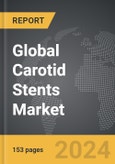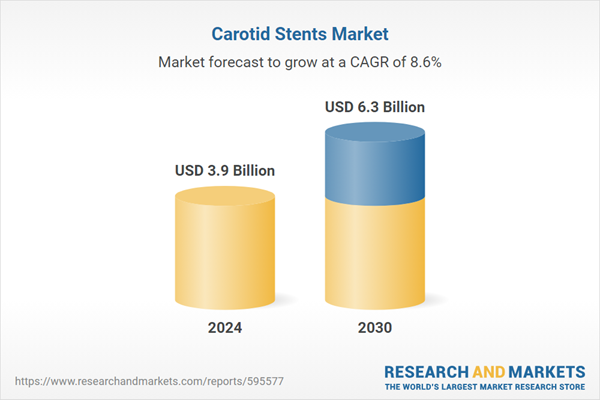The global market for Carotid Stents was valued at US$3.9 Billion in 2024 and is projected to reach US$6.3 Billion by 2030, growing at a CAGR of 8.6% from 2024 to 2030. This comprehensive report provides an in-depth analysis of market trends, drivers, and forecasts, helping you make informed business decisions. The report includes the most recent global tariff developments and how they impact the Carotid Stents market.
Segments: Type (Balloon Expandable Stents, Self-Expanding Stents).
Geographic Regions/Countries: World; United States; Canada; Japan; China; Europe (France; Germany; Italy; United Kingdom; Spain; Russia; and Rest of Europe); Asia-Pacific (Australia; India; South Korea; and Rest of Asia-Pacific); Latin America (Argentina; Brazil; Mexico; and Rest of Latin America); Middle East (Iran; Israel; Saudi Arabia; United Arab Emirates; and Rest of Middle East); and Africa.
The analysts continuously track trade developments worldwide, drawing insights from leading global economists and over 200 industry and policy institutions, including think tanks, trade organizations, and national economic advisory bodies. This intelligence is integrated into forecasting models to provide timely, data-driven analysis of emerging risks and opportunities.
Global Carotid Stents Market - Key Trends & Drivers Summarized
What Are Carotid Stents and How Do They Prevent Stroke?
Carotid stents are small, flexible tubes used to open narrowed carotid arteries, which are located on each side of the neck and are the primary suppliers of blood to the brain. The procedure to place a stent, known as carotid artery stenting, is a common treatment for carotid artery disease, a major risk factor for stroke. The stenting helps prevent stroke by alleviating obstructions in the carotid arteries, allowing for unimpeded blood flow. This is typically done in conjunction with a technique called angioplasty, where a balloon is used to expand the artery before a stent is placed. This method is particularly advantageous for patients considered at high risk for traditional carotid surgery, offering a minimally invasive alternative with comparable outcomes.How Is Technological Advancement Enhancing Carotid Stent Procedures?
Technological advancements are significantly enhancing the safety and efficacy of carotid stenting procedures. Innovations in stent design, such as the introduction of dual-layer stents and those made from bioabsorbable materials, promise better compatibility with the body and reduced risk of future blockages or complications. Imaging technologies like advanced ultrasound, MRI, and real-time monitoring during stenting procedures have improved dramatically, allowing surgeons to achieve more precise placements of stents. Furthermore, developments in robotic surgery are beginning to permeate the field, potentially offering even greater precision, reduced recovery times, and minimal surgical risks. These technological enhancements contribute to better patient outcomes and have increased the acceptance of carotid stenting as a safe alternative to surgical procedures.What Are the Current Trends Impacting the Carotid Stents Industry?
Several current trends are influencing the carotid stents industry, driven by demographic, technological, and regulatory factors. The aging global population is a significant driver, as older adults are more prone to carotid artery disease. There is also a growing preference for minimally invasive surgeries over traditional surgical methods, particularly among patients with multiple comorbidities for whom surgery poses high risks. In response to these trends, there is an increasing demand for more advanced, patient-friendly stenting options that offer reduced recovery times and lower risk of complications. Regulatory trends are also shaping the industry, as governments and healthcare bodies increase scrutiny and demand higher standards of efficacy and safety for medical devices used in critical care settings.What Drives the Growth of the Carotid Stents Market?
The growth in the carotid stents market is driven by several factors, including technological innovations that have improved the safety and efficacy of stent implants. An increase in the prevalence of cardiovascular diseases and stroke risk among the aging population worldwide necessitates effective interventions like carotid stenting. There is also a growing body of clinical evidence supporting the long-term benefits of carotid stenting over alternative surgical methods, which bolsters its adoption among healthcare providers. Additionally, advancements in medical imaging and surgical techniques have expanded the potential patient base for carotid stenting by enabling the treatment of cases that were previously deemed unsuitable for this approach. Consumer behavior that increasingly favors minimally invasive treatments with shorter hospital stays and recovery times also contributes to the rising demand for carotid stenting procedures.Report Scope
The report analyzes the Carotid Stents market, presented in terms of units. The analysis covers the key segments and geographic regions outlined below.Segments: Type (Balloon Expandable Stents, Self-Expanding Stents).
Geographic Regions/Countries: World; United States; Canada; Japan; China; Europe (France; Germany; Italy; United Kingdom; Spain; Russia; and Rest of Europe); Asia-Pacific (Australia; India; South Korea; and Rest of Asia-Pacific); Latin America (Argentina; Brazil; Mexico; and Rest of Latin America); Middle East (Iran; Israel; Saudi Arabia; United Arab Emirates; and Rest of Middle East); and Africa.
Key Insights:
- Market Growth: Understand the significant growth trajectory of the Balloon Expandable Stents segment, which is expected to reach US$4.3 Billion by 2030 with a CAGR of a 8.1%. The Self-Expanding Stents segment is also set to grow at 9.6% CAGR over the analysis period.
- Regional Analysis: Gain insights into the U.S. market, valued at $1.0 Billion in 2024, and China, forecasted to grow at an impressive 12.2% CAGR to reach $1.4 Billion by 2030. Discover growth trends in other key regions, including Japan, Canada, Germany, and the Asia-Pacific.
Why You Should Buy This Report:
- Detailed Market Analysis: Access a thorough analysis of the Global Carotid Stents Market, covering all major geographic regions and market segments.
- Competitive Insights: Get an overview of the competitive landscape, including the market presence of major players across different geographies.
- Future Trends and Drivers: Understand the key trends and drivers shaping the future of the Global Carotid Stents Market.
- Actionable Insights: Benefit from actionable insights that can help you identify new revenue opportunities and make strategic business decisions.
Key Questions Answered:
- How is the Global Carotid Stents Market expected to evolve by 2030?
- What are the main drivers and restraints affecting the market?
- Which market segments will grow the most over the forecast period?
- How will market shares for different regions and segments change by 2030?
- Who are the leading players in the market, and what are their prospects?
Report Features:
- Comprehensive Market Data: Independent analysis of annual sales and market forecasts in US$ Million from 2024 to 2030.
- In-Depth Regional Analysis: Detailed insights into key markets, including the U.S., China, Japan, Canada, Europe, Asia-Pacific, Latin America, Middle East, and Africa.
- Company Profiles: Coverage of players such as Abbott Laboratories, Inc., Balton Sp z o.o., Boston Scientific Corporation, Cardinal Health, Inc., InspireMD Inc. and more.
- Complimentary Updates: Receive free report updates for one year to keep you informed of the latest market developments.
Some of the 12 companies featured in this Carotid Stents market report include:
- Abbott Laboratories, Inc.
- Balton Sp z o.o.
- Boston Scientific Corporation
- Cardinal Health, Inc.
- InspireMD Inc.
- Medtronic PLC
- Optimed Medizinische Instrumente GmbH
- Terumo Europe NV
- W. L. Gore & Associates, Inc.
Tariff Impact Analysis: Key Insights for 2025
Global tariff negotiations across 180+ countries are reshaping supply chains, costs, and competitiveness. This report reflects the latest developments as of April 2025 and incorporates forward-looking insights into the market outlook.The analysts continuously track trade developments worldwide, drawing insights from leading global economists and over 200 industry and policy institutions, including think tanks, trade organizations, and national economic advisory bodies. This intelligence is integrated into forecasting models to provide timely, data-driven analysis of emerging risks and opportunities.
What’s Included in This Edition:
- Tariff-adjusted market forecasts by region and segment
- Analysis of cost and supply chain implications by sourcing and trade exposure
- Strategic insights into geographic shifts
Buyers receive a free July 2025 update with:
- Finalized tariff impacts and new trade agreement effects
- Updated projections reflecting global sourcing and cost shifts
- Expanded country-specific coverage across the industry
Table of Contents
I. METHODOLOGYII. EXECUTIVE SUMMARY2. FOCUS ON SELECT PLAYERSIII. MARKET ANALYSISIV. COMPETITION
1. MARKET OVERVIEW
3. MARKET TRENDS & DRIVERS
4. GLOBAL MARKET PERSPECTIVE
UNITED STATES
CANADA
JAPAN
CHINA
EUROPE
FRANCE
GERMANY
ITALY
UNITED KINGDOM
SPAIN
RUSSIA
REST OF EUROPE
ASIA-PACIFIC
AUSTRALIA
INDIA
SOUTH KOREA
REST OF ASIA-PACIFIC
LATIN AMERICA
ARGENTINA
BRAZIL
MEXICO
REST OF LATIN AMERICA
MIDDLE EAST
IRAN
ISRAEL
SAUDI ARABIA
UNITED ARAB EMIRATES
REST OF MIDDLE EAST
AFRICA
Companies Mentioned (Partial List)
A selection of companies mentioned in this report includes, but is not limited to:
- Abbott Laboratories, Inc.
- Balton Sp z o.o.
- Boston Scientific Corporation
- Cardinal Health, Inc.
- InspireMD Inc.
- Medtronic PLC
- Optimed Medizinische Instrumente GmbH
- Terumo Europe NV
- W. L. Gore & Associates, Inc.
Table Information
| Report Attribute | Details |
|---|---|
| No. of Pages | 153 |
| Published | April 2025 |
| Forecast Period | 2024 - 2030 |
| Estimated Market Value ( USD | $ 3.9 Billion |
| Forecasted Market Value ( USD | $ 6.3 Billion |
| Compound Annual Growth Rate | 8.6% |
| Regions Covered | Global |









